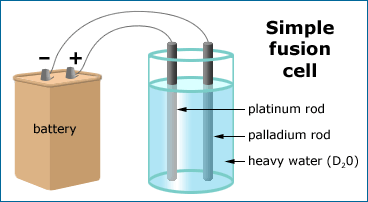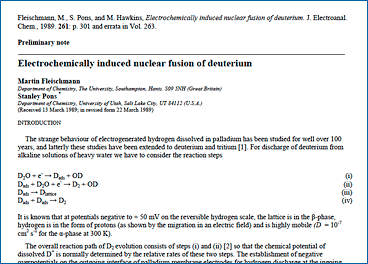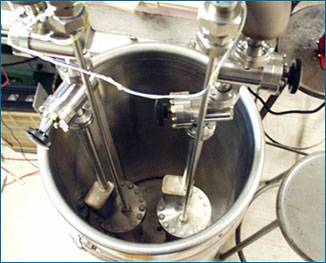Fusion occurs when two light atoms, like hydrogen, join together, or fuse, into a single heavier atom, releasing a lot of energy in the process. In 1989, chemists Stanley Pons and Martin Fleischmann excited the world with claims that they had produced fusion at room temperature — “cold” fusion compared to the high temperatures the process was thought to require. Their discovery seemed to offer a potential solution to the energy crisis: cheap energy, without pollutants or radioactive waste.
Use the science checklist to see how Pons and Fleischmann’s work measures up:

![]() Focuses on the natural world?
Focuses on the natural world?
Fusion is the energy source of stars, like our sun. Inside the sun, fusion takes place at about 27,000,000° F. Pons and Fleischmann attempted to produce fusion at just 70° F and to fuse together pairs of deuterium atoms. Commonly found in seawater, a deuterium atom is a hydrogen atom with one extra neutron.
![]() Aims to explain the natural world?
Aims to explain the natural world?
Other scientists had shown that the element palladium, a rare metal, can absorb large amounts of deuterium. Pons and Fleischmann hypothesized that inside a sample of palladium, deuterium atoms would be forced close enough to cause them to fuse together. If fusion were actually occurring inside palladium, it could help explain the unusually high absorption of deuterium. Pons and Fleischmann were certainly interested in this explanation; however, they were mainly motivated by the societal benefits that could be realized if their idea of creating an energy source at low temperature worked.

![]() Uses testable ideas?
Uses testable ideas?
Pons and Fleischmann built a “fusion cell,” essentially consisting of two pieces of metal, one palladium and the other platinum, submerged in a container of heavy water (water in which the hydrogen is replaced by deuterium). An electric current split the heavy water molecules, producing deuterium gas and oxygen. The deuterium could then be absorbed into the palladium. If fusion were occurring inside the palladium, they would expect it to produce a large amount of energy. Furthermore, nuclear theory — the theory of how protons and neutrons interact with each other — indicated that the initial product of fusion would be helium-4 (helium with two neutrons), which would then rapidly release either a neutron, a proton, or gamma radiation. Based on the amount of energy produced by the deuterium interaction, nuclear theory could be used to make a prediction about how much of each of these byproducts should be produced if fusion were actually occurring.
![]() Relies on evidence?
Relies on evidence?
Pons and Fleischmann found that their experiment produced a huge amount of energy — so much that they saw fusion as the only explanation. However, neither the number of neutrons nor the amount of gamma radiation measured matched the expectations generated by nuclear theory. And Pons and Fleischmann didn’t initially check to see if their experiment had produced any helium. Eventually, helium measurements were made and were found to be inconsistent with the idea that cold fusion had taken place. In addition, another research group — this one headed by nuclear physicist Steven Jones — performed similar experiments but found conflicting results. Pons and Fleischmann decided to ignore these results.

![]() Involves the scientific community?
Involves the scientific community?
Jones had just built a state-of-the-art neutron detector and had the expertise in neutron detection that Pons and Fleischmann lacked; however, Pons and Fleischmann declined to collaborate with him. In fact, they did their work in secrecy, not even consulting members of their own physics department. Given the importance of their results, the U.S. editor of the Journal of Electroanalytical Chemistry — and personal contact of Pons — offered to get Pons and Fleischmann’s paper through the review process quickly. By setting tight deadlines for the reviewers and agreeing upon revisions between themselves (instead of sending them back to reviewers for approval as is customary), a process that normally takes months took just nine days. Then, before their work was published — before it could be reviewed by the scientific community as a whole — they held a press conference to announce their results.

![]() Leads to ongoing research?
Leads to ongoing research?
Given the potential of their findings to solve the world’s energy problems and revise nuclear theory, many scientists rushed to confirm Pons and Fleischmann’s results. Not only did experimentalists try to repeat the experiment, but also many theorists examined a variety of potential effects going on inside the palladium that might account for Pons and Fleischmann’s findings. However, most could not find any evidence in support of fusion. A few experiments produced an excess of energy that might be attributable to fusion, but none could produce the result on cue: sometimes they produced excess energy, sometimes they didn’t. These spotty results were a major blow to cold fusion. By the end of 1989, most scientists had written off Pons and Fleischmann’s ideas. However, a few scientists continued with research in this vein, trying to figure out why the palladium-deuterium experiment was so unpredictable and how it could be reconciled with the rest of physics. Some of this work continues today.
![]() Researchers behave scientifically?
Researchers behave scientifically?
One mark of scientists is that they pay attention to what has already been done. Typically, scientists study their fields extensively, but as electrochemists, neither Pons nor Fleischmann had studied the field of nuclear physics in depth. Despite this, they refused the help of scientists who had the knowledge they lacked and chose to disregard the results of those scientists. They failed to communicate their ideas and tests openly to others, leaving out key technical details from their paper that made it difficult for other scientists to repeat the experiment and replicate their results. They also initially failed to perform several quick tests that could have provided evidence refuting their hypothesis. Only after significant pressure from the scientific community did Pons and Fleischmann allow their palladium to be analyzed for the fusion byproduct helium.
Now you decide. How does Pons and Fleischmann’s investigation of cold fusion measure up to the science checklist?
To see our answer, click here.
There’s nothing unscientific about cold fusion research itself. Indeed, using experiments to study the interactions among atoms is pretty stereotypical of science. And forming a hypothesis that winds up not being supported by evidence is a common occurrence in mainstream science. Even if a hypothesis is “wrong” and has to be abandoned, the investigation still adds valuable information to our knowledge base. The elements of this story that deviate from scientific norms involve the researchers’ behavior: Bypassing the feedback of the scientific community, ignoring evidence, and not trying to find evidence that contradicts a pet hypothesis are behaviors antithetical to the goals of science.
So is it science? This case demonstrates science’s fuzzy borders. The research ended up producing scientific information (even if just about what doesn’t happen in a particular situation), but the investigators’ behavior carried the study away from the solidly scientific.
